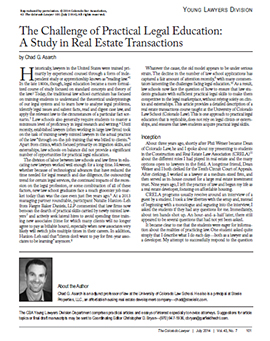Teaching Practical Legal Skills in a Strictly Classroom Setting
 Chad G. Asarch recently wrote an article in The Colorado Lawyer discussing the Real Estate Transactions course he teaches, which emphasizes practical legal skills in a non-clinical, traditional classroom setting. In contemplating the structure of the course, Asarch analyzed the actual work practicing lawyers undertake in representing a client in a real estate transaction and identified two main tasks: the ability to draft a transaction document and to identify potential changes to a transaction document prepared by counsel representing other parties to the transaction.
Chad G. Asarch recently wrote an article in The Colorado Lawyer discussing the Real Estate Transactions course he teaches, which emphasizes practical legal skills in a non-clinical, traditional classroom setting. In contemplating the structure of the course, Asarch analyzed the actual work practicing lawyers undertake in representing a client in a real estate transaction and identified two main tasks: the ability to draft a transaction document and to identify potential changes to a transaction document prepared by counsel representing other parties to the transaction.
Class assignments were designed to make students perform these tasks, as counsel for both sides of the transaction. Throughout the course, students learned about their roles and expectations, as well as the underlying law, and students' "results exceeded [his] expectations."
My experience demonstrates that it is possible to teach law students practical/applied lawyering skills in a classroom (non-clinical/non-externship) setting. It also shows that the students crave such instruction.
Asarch believes that "formalized law school education remains the most efficient and effective way to teach students the basic fundamental components of the law," but he also believes that law schools have the responsibility to teach practical skills to their students. “[T]o prepare students for their lives as lawyers after graduation, law schools need to teach the skills of lawyering in addition to the theory of the law.” His experience makes evident that teaching such skills is possible, not only in clinics, but in a strictly classroom setting.
Riley Combelic is a third-year law student at the University of Denver Sturm College of Law and contributes to IAALS Online. Please direct inquiries about this post to iaals@du.edu.


